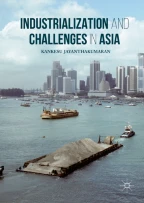Regional Trade Agreements (RTA) and the Association of Southeast Asian Nations (ASEAN)

Jayanthakumaran provides an updated summary of the Association of South East Asian Nations (ASEAN) and its economic, political, and social performances in the light of integration. By focusing on a continuous willingness to integrate regionally and globally, the chapter also draws attention to the stepping stone attitude towards regionalism rather than as a detrimental force for the region. ASEAN’s globally oriented commitment is reflected by the recent Regional Comprehensive Economic Partnership (RCEP) integration arrangement with Australia, China, India, Japan, South Korea, and New Zealand. Jayanthakumaran explores the recent developments and challenges that lie ahead regarding poverty and income inequality, and suggests using appropriate migration policies, innovative labour saving technologies, and appropriate energy and environmental strategies.
This is a preview of subscription content, log in via an institution to check access.
Access this chapter
Subscribe and save
Springer+ Basic
€32.70 /Month
- Get 10 units per month
- Download Article/Chapter or eBook
- 1 Unit = 1 Article or 1 Chapter
- Cancel anytime
Buy Now
Price includes VAT (France)
eBook EUR 74.89 Price includes VAT (France)
Softcover Book EUR 94.94 Price includes VAT (France)
Hardcover Book EUR 137.14 Price includes VAT (France)
Tax calculation will be finalised at checkout
Purchases are for personal use only
References
- Ariff, M. (1994). Open regionalism a la ASEAN. Journal of Asian Economics, 5(1), 99–117. ArticleGoogle Scholar
- ASEAN Secretariat. (2012). ASEAN community in figures (ACIF) 2011. Jakarta: ASEAN Secretariat. Google Scholar
- ASEAN Secretariat. (2013). ASEAN community in figures. Jakarta. Google Scholar
- ASEAN Secretariat. (2014). ASEAN community in figures: Special edition 2014, Jakarta. Google Scholar
- Asian Development Bank. (ADB) (2014). Poverty in Asia: A deeper look. Part 1 – Special chapter in key indicators for Asia and the Pacific 2014, 45th edn., Manila. Google Scholar
- Asian Productivity Organization. (APO) (2015). APO productivity database 2014 version. http://www.apo-tokyo.org/wedo/measurement. Accessed 21 Aug 2015.
- Chia, S. Y. (2013). The ASEAN economic community: Progress, challenges and prospects. ADBI working paper series 440, Asian Development Bank Institute, Tokyo. Google Scholar
- Elliott, R. J. R., & Ikemoto, K. (2004). AFTA and the Asian crisis: Help or hindrance to ASEAN intra-regional trade? Asian Economic Journal, 18(1), 1–23. Google Scholar
- Ethier, W. J. (1998). Regionalism in a multilateral world. The Journal of Political Economy, 106(6), 1214–1245. ArticleGoogle Scholar
- Ghose, A. K. (2004). Global inequality and international trade. Cambridge Journal of Economics, 28(2), 229–252. ArticleGoogle Scholar
- Gropello, E., Tan, H., & Tandon, P. (2010). Skills for the labor market in the Philippines. Washington, DC: The World Bank. BookGoogle Scholar
- Hickey, M., Narendra, P., & Rainwater, K. (2013). A review of internal and regional migration policy in Southeast Asia. Working paper 8, Asia Research Institute, National University of Singapore, Singapore. Google Scholar
- Hurley, D. (2003). Horizontal and vertical intra-industry trade: The case of Asean trade in manufactures. International Economic Journal, 17(4), 1–14. ArticleGoogle Scholar
- IEA. (2013). Southeast Asia energy outlook, France. www.iea.org
- Imada, P. (1993). Production and trade effects of an ASEAN free trade area. The Developing Economies, 31(1), 3–23. Google Scholar
- Jayanthakumaran, K., & Lee, S.-W. (2013). Evidence on the convergence of per capita income: A comparison of founder members of the association of Southeast Asian Nations and the South Asian association of regional cooperation. Pacific Economic Review, 18(1), 108–121. ArticleGoogle Scholar
- Jayanthakumaran, K., & Sanidas, E. (2007). The complementarity hypothesis of integration: Regionalism multilateralism and the ASEAN-5. The Asia Pacific Journal of Economics and Business, 11(1), 40–60. Google Scholar
- Jongwanich, J., & Kohpaiboon, A. (2007). Determinants of protection in Thai manufacturing. Economic Papers, 26(3), 276–294. ArticleGoogle Scholar
- Krueger, A. O. (1999). Are preferential trading arrangements trade-liberalizing or protectionist? Journal of Economic Perspectives, 13, 105–124. ArticleGoogle Scholar
- Mahani, Z.-A. (2002). ASEAN integration: At risk of going in different directions. World Economy, 25(9), 1263–1277. ArticleGoogle Scholar
- Menon, J. (1998). The expansion of AFTA: Widening or deepening. Asian-Pacific Economic Literature, 12(2), 10–22. ArticleGoogle Scholar
- Montreevat, S., & Rajan, R. S. (2003). Financial crisis, bank restructuring and foreign bank entry: An analytical case study of Thailand. Asia Pacific Journal of Economics and Business, 7(2), 53–77. Google Scholar
- Ornelas, E. (2005). Trade creating free trade areas and the undermining of multilateralism. European Economic Review, 49, 1717–1735. ArticleGoogle Scholar
- Park, D. (2000). Intra-Southeast Asian convergence. ASEAN Economic Bulletin, 17(3), 285–292. ArticleGoogle Scholar
- Park, J. (2010). Projection of long-term total factor productivity growth for 12 Asian Economies. ADB Economics working paper series no. 227. Manila: ADB. Google Scholar
- UN DESA. (2013b). Trends in international migrant stock. New York: United Nations, Department of Economic and Social Affairs (UN DESA), Population Division Database. Google Scholar
- Urata, S., & Okabe, M. (2013). The impact of AFTA on intra- AFTA trade. Economic Research Institute for ASEAN and East Asia (ERIA) working papers DP-2013-05. Google Scholar
- Viner, J. (1950). The customs union issue. New York: Carnegie Endowment for International Peace. Google Scholar
- Wilson, E. J., Jayanthakumaran, K., & Verma, R. (2012). Demographics, labor mobility, and productivity. ADBI working paper series no. 387, ADBI, Tokyo. Google Scholar
- World Bank. (2012). Capturing new source of growth: East Asia and Pacific economic update. Washington, DC: World Bank. Google Scholar
- World Bank. (2014). World development indicators. Washington, DC: World Bank. Google Scholar
Author information
Authors and Affiliations
- University of Wollongong School of Economics, Wollongong, New South Wales, Australia Kankesu Jayanthakumaran
- Kankesu Jayanthakumaran

